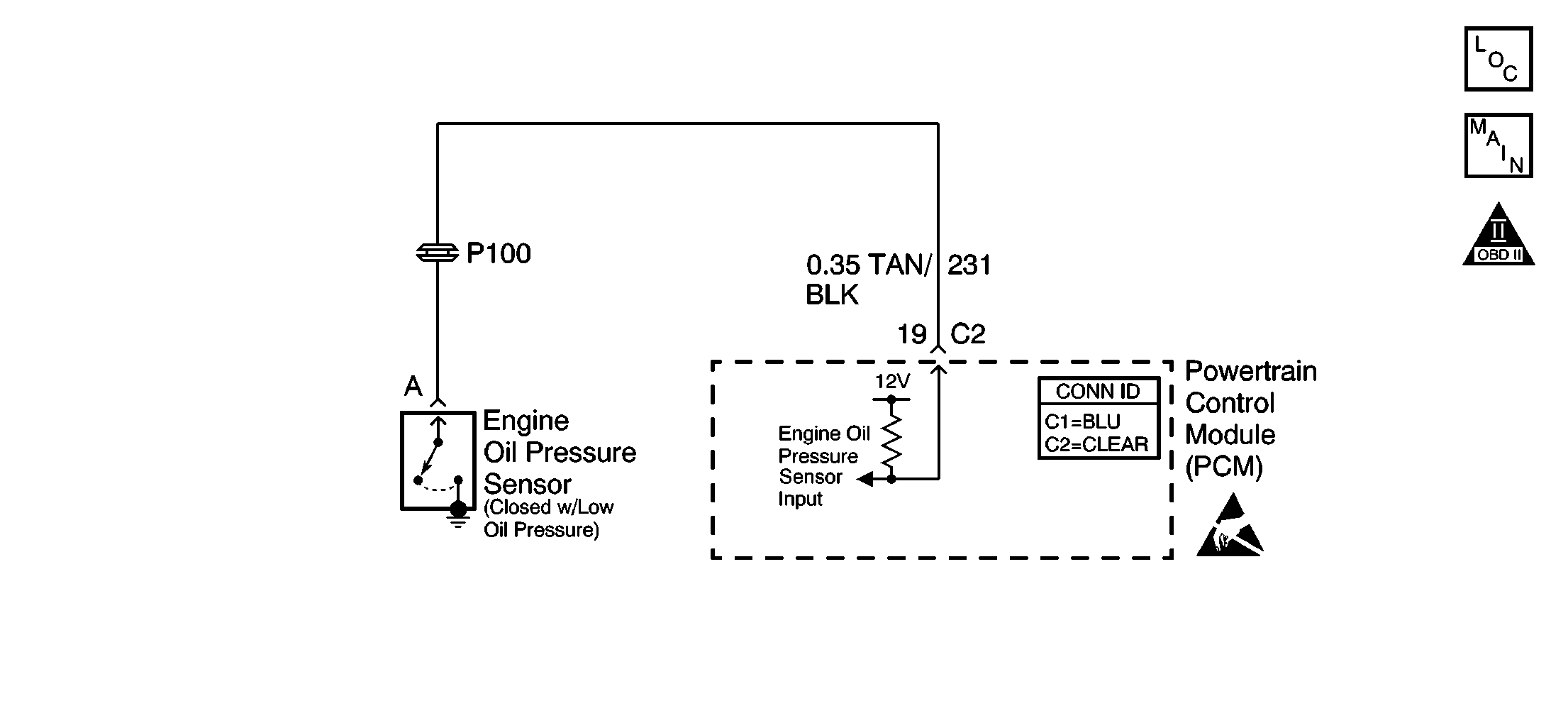
Circuit Description
The low oil pressure sensor is normally closed. When oil pressure increases above 1 to 4.5 psi the switch contacts open. The powertrain control module (PCM) supplies 12 volts to the oil pressure input circuit. With low oil pressure the 12 volts is pulled low to ground. This diagnostic tests for an open condition of the oil pressure switch circuit. If the engine has been off long enough for engine temperature to drop by 10°C (50°F), then a shorted, low oil pressure, condition of the circuit should be observed prior to engine running. If the engine has not been cranked and oil pressure has been detected DTC P1189 will set.
Conditions for Running the DTC
| • | DTCs P0117, P0118, P1111, and P1114 are not set. |
| • | The ignition is ON. |
| • | The engine is OFF. |
| • | Engine temperature 10°C (50°F) is less than last key OFF temperature. |
Conditions for Setting the DTC
Circuit open for 10 seconds.
Action Taken When the DTC Sets
| • | The PCM will illuminate the malfunction indicator lamp (MIL) during the second consecutive trip in which the diagnostic test has been run and failed. |
| • | The PCM will store conditions which were present when the DTC set as Freeze Frame/Failure Records data. |
Conditions for Clearing the MIL/DTC
| • | The DTC becomes history when the conditions for setting the DTC are no longer present. |
| • | The history DTC clears after 40 malfunction free warm-up cycles. |
| • | The PCM receives a clear code command from the scan tool. |
Diagnostic Aids
Inspect the oil pressure sensor input and ground circuits for an intermittent open or poor oil pressure sensor terminal contact. With the engine OFF the oil pressure display on the scan tool should indicate LOW. An open sensor/circuit would indicate LOW with the engine OFF.
Inspect for the following conditions:
Many situations may lead to an intermittent condition. Perform each inspection or test as directed.
Important: : Remove any debris from the connector surfaces before servicing a component. Inspect the connector gaskets when diagnosing or replacing a component. Ensure that the gaskets are installed correctly. The gaskets prevent contaminate intrusion.
| • | Loose terminal connection |
| - | Use a corresponding mating terminal to test for proper tension. Refer to Testing for Intermittent Conditions and Poor Connections , and to Connector Repairs in Wiring Systems for diagnosis and repair. |
| - | Inspect the harness connectors for backed out terminals, improper mating, broken locks, improperly formed or damaged terminals, and faulty terminal to wire connection. Refer to Testing for Intermittent Conditions and Poor Connections , and to Connector Repairs in Wiring Systems for diagnosis and repair. |
| • | Damaged harness--Inspect the wiring harness for damage. If the harness inspection does not reveal a problem, observe the display on the scan tool while moving connectors and wiring harnesses related to the sensor. A change in the scan tool display may indicate the location of the fault. Refer to Wiring Repairs in Wiring Systems for diagnosis and repair. |
| • | Inspect the powertrain control module (PCM) and the engine grounds for clean and secure connections. Refer to Wiring Repairs in Wiring Systems for diagnosis and repair. |
If the condition is determined to be intermittent, reviewing the Snapshot or Freeze Frame/Failure Records may be useful in determining when the DTC or condition was identified.
Test Description
The numbers below refer to the step numbers on the diagnostic table:
-
This step tests to see if LOW engine oil pressure is displayed when the engine not running.
-
This step tests to see if the oil pressure switch or wiring is at fault.
-
This step tests to see if the oil pressure switch input circuit or the PCM is at fault.
-
This step ensures that the replacement PCM, which utilizes an electrically erasable programmable read only memory (EEPROM), is programmed when installed.
Step | Action | Values | Yes | No |
|---|---|---|---|---|
1 | Did you perform the Powertrain On Board Diagnostic (OBD) System Check? | -- | ||
Does the scan tool indicate low oil pressure? | -- | Go to Diagnostic Aids | ||
Does the scan tool indicate oil pressure low? | -- | |||
Is the resistance the same or less than the value specified? | 5ohms | |||
5 | Repair the open in either the oil pressure sensor input circuit or the oil pressure sensor ground circuit. Refer to Wiring Repairs in Wiring Systems. Did you find and correct the condition? | -- | -- | |
6 | Inspect for poor connections at the harness connector of the oil pressure sensor connector. Refer to Testing for Intermittent Conditions and Poor Connections and to Connector Repairs in Wiring Systems. Did you find and correct the condition? | -- | ||
7 | Inspect for poor connections at the harness connector of the PCM. Refer to Testing for Intermittent Conditions and Poor Connections and to Connector Repairs in Wiring Systems. Did you find and correct the condition? | -- | ||
8 | Replace the oil pressure sensor. Refer to Engine Oil Pressure Sensor and/or Switch Replacement . Did you complete the replacement? | -- | -- | |
|
Important: The replacement PCM must be programmed. Replace the PCM. Refer to Powertrain Control Module Replacement/Programming . Did you complete the replacement? | -- | -- | ||
10 |
Does the DTC reset? | -- | System OK |
